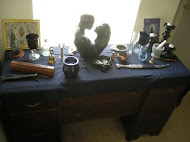I found these directions at Full Moon Magic - this site has all kinds of great info! I wanted to go ahead and post this, because a lot of the spells and rituals I post call for "special" incense to be used. This way, I can refer folks back here for basic instructions, and just include the necessary ingredients in the posts themselves :)
Ingredients
- Barbecue Charcoals
- Potassium Nitrate**
- Egg Whites - or - Plain Knox Gelatin - or - Agar
The hardest part of this recipe is grinding up the charcoals, they're really a bugger to pulverize. I've had the best luck using a hammer. You could just hit them with it, but then you'd have charcoal bits flying everywhere. You have to contain them in something that won't be punctured by the sharp pieces while you pound them up. I have tried a number of sorts of bags and canvas works the best. The problem is getting a canvas bag. I don't know of anywhere they are sold, I happened to have some from some sandbags. You could sew one, they sell canvas or poplin at every fabric store. Put the charcoals, the regular barbecue kind, in the bag about 5-7 at a time and pound away. Get as close to powder as you can re-pounding the larger pieces to break them up more.
When you have your charcoal ready you add potassium nitrate powder, one part to three parts of charcoal powder. You can buy the potassium nitrate at the pharmacy in that little section where they have the iodine and flowers of sulfur. The potassium nitrate is what will keep the charcoal burning. To form the loose powder into patties you add egg whites, just the whites, until you create a paste. How many egg whites you will require depends upon how many charcoals you used. Just keep adding them until you can get the paste to hold together. You may substitute plain, unflavored, Knox gelatin mixed with enough warm water to dissolve it into a thick gel if you like. Vegans may use agar from the health food store which is a seaweed product.
Form the paste into little patties about 1 1/2 to 2 inches across. You can use those mini muffin tins if you have them. Let the patties dry completely, this may take a couple of days. You want them crispy with no wet centers. When they are absolutely dry you can store them in tightly closed glass jars to keep them fresh. If you keep them in plastic bags they will draw damp and not burn properly. To use the charcoals you must have a proper incense burner. If placed in a glass or ceramic container to burn it may shatter and a metal container will burn the surface it sits on. They will become too hot to use in a ceramic or glass container without sand or salt in it to absorb and dissipate the heat. You can use a bowl of any sort with about two inches of either sand or salt in it. Light the charcoal with a match, it may take a try or two. The burning charcoal may sparkle or pop a bit, this is the potassium nitrate. You may notice a slight scent from the burning egg white, but it goes away. Put the herb, wood, resin or oil on the smoldering charcoal to burn.
When mixing incense ingredients, a part can be 1 teaspoon, 1 cup, 1 pound; anything you want depending upon how much incense you want to make. I recommend starting with teaspoons along with the appropriate fractions of a teaspoon. Measurements can be cut down to produce a smaller quantity. The ratios of ingredients may be altered to suit your sense of smell. None of these incenses will remain lit by themselves, they must be smoldered on charcoals.
**Whatever the volume and shape, combustible incense is always made with potassium nitrate, better known as salt peter. This helps the incense to burn well, and evenly. You can find potassium nitrate in nearly any drug store, although you may have to ask the pharmacist for it.
Disclaimer: No one involved in this blog or its contents may be held responsible for any adverse reactions arising from following any of the instructions/recipes on this list. It is the reader's personal responsibility to exercise all precautions and use his or her own discretion if following any instructions or advice from this blog.















No comments:
Post a Comment